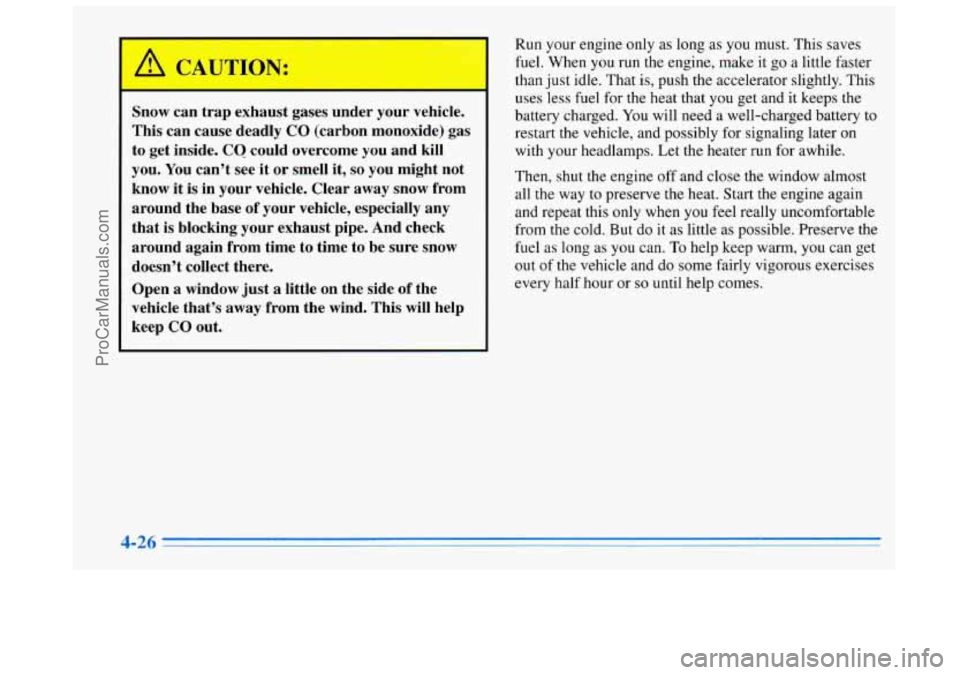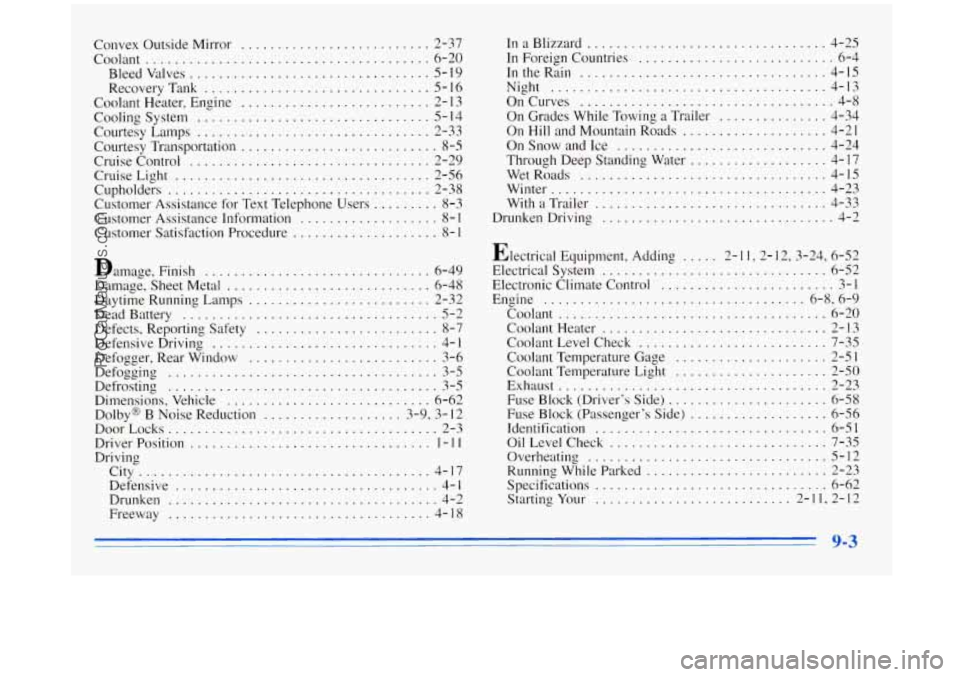Page 178 of 356

Snow can trap exhaust gases under your vehicle.
This can cause deadly CO (carbon monoxide) gas
to get inside.
CO could overcome you and kill
you. You can’t see it
or smell it, so you might not
know it is in your vehicle. Clear away snow from
around the base of your vehicle, especially any
that is blocking your exhaust pipe. And check
around again from time to time to be sure snow
doesn’t collect there.
Open
a window just a little on the side of the
vehicle that’s away from the wind. This will help
keep CO out.
Run your engine only as long as you must. Ths saves
fuel. When you run the engine, make it go a little faster
than just idle. That is, push the accelerator slightly. This
uses less fuel for the heat that you get and
it keeps the
battery charged. You will need a well-charged battery
to
restart the vehicle, and possibly for signaling later on
with your headlamps. Let the heater run for awhile.
Then, shut the engine
off and close the window almost
all
the way to preserve the heat. Start the engine again
and repeat this
only when you feel really uncomfortable
from the cold. But do it as little as possible. Preserve the
fuel as long as you can.
To help keep warm, you can get
out of the vehicle and do some fairly vigorous exercises
every half hour or
so until help comes.
ProCarManuals.com
Page 193 of 356
7. Connect the red positive (+) cable to the positive (+)
terminal of the vehicle with the dead battery. Use a
remote positive (+) terminal if the vehicle has one.
8. Don’t let the other end
touch metal. Connect
it to the positive
(+)
terminal of the good
battery.
Use a remote
positive
(+) terminal if
the vehicle has one.
9 Now connect the black
negative
(-) cable to
the good battery’s
negative
(-) terminal.
Don’t let the other end
touch anything until the
next step. The other end
of the negative cable
duesn ’t go to the
dead battery.
It goes to
a heavy, unpainted, metal part on the engine of
the vehicle
with the dead battery.
ProCarManuals.com
Page 194 of 356
10.
11.
12.
Attach the cable at least 18 inches (45 cm) away
from the dead battery, but not near engine parts that
move. The electrical connection is just as good
there, but the chance
of sparks getting back to the
battery is much less.
Now start the vehicle with the good battery and run
the engine for a while.
Try to start the vehicle with the dead battery. If it
won’t start after a few tries, it probably needs service. electrical shorting. Take
care that they don’t touch
each other or any other metal.
13. Remove the cables in reverse order to prevent
IC+
A. Heavy Metal Engine Part
B. Good Battery
C. Dead Battery
5-6
ProCarManuals.com
Page 347 of 356

Convex Outside Mirror .......................... 2-37
Coolant
....................................... 6-20
Bleedvalves
................................. 5-19
RecoveryTank
............................... 5-16
Coolant Heater. Engine
.......................... 2- I3
Cooling System
................................ 5- I4
Courtesy Lamps
................................ 2-33
Courtesy Transportation
........................... 8-5
Cruise Control
................................. 2-29
CruiseLight
................................... 2-56
Cupholders
.................................... 2-38
Customer Assistance for Text Telephone Users
......... 8-3
Customer Assistance Information
................... 8- 1
Customer Satisfaction Procedure .................... 8- 1
Damage. Finish ............................... 6-49
Damage. Sheet Metal
............................ 6-48
Daytime Running Lamps
......................... 2-32
Dead Battery
................................... 5-2
Defects. Reporting Safety ......................... 8-7
Defensive Driving ............................... 4- 1
Defogger. Rear Window .......................... 3-6
Defogging
..................................... 3-5
Defrosting
..................................... 3-5
Dimensions, Vehicle
............................ 6-62
Dolby@
B Noise Reduction ................... 3-9, 3- 12
DoorLocks
..................................... 2-3
Driver Position
................................. 1 - 1 1
Driving
City
........................................ 4-17
Defensive
.................................... 4-1
Drunken
..................................... 4-2
Freeway
.................................... 4-18 InaBlizzard
................................. 4-25
In Foreign Countries
........................... 6-4
IntheRain
.................................. 4-15
Night
...................................... 4-13
OnCurves
................................... 4-8
On Grades While Towing
a Trailer ............... 4-34
On Hill and Mountain Roads
.................... 4-21
OnSnowandIce
............................. 4-24
Through Deep Standing Water
................... 4-17
WetRoads
.................................. 4-15
Winter
...................................... 4-23
With a Trailer
................................ 4-33
Drunken Driving
................................ 4-2
Electrical Equipment, Adding
..... 2- I I, 2- 12, 3-24, 6-52
Electrical System
............................... 6-52
Electronic Climate Control
........................ 3-1
Engine
.................................... 6-8, 6-9
Coolant
..................................... 6-20
Coolant Heater
............................... 2-13
Coolant Level Check
.......................... 7-35
Coolant Temperature Gage
..................... 2-51
Coolant Temperature Light
..................... 2-50
Exhaust
..................................... 2-23
Fuse Block (Driver’s Side)
...................... 6-58
Fuse Block (Passenger’s Side)
................... 6-56
Identification
................................ 6-51
OilLevelCheck
.............................. 7-35
Overheating
................................. 5-12
Running While Parked
......................... 2-23
Specifications
................................ 6-62
Starting
Your ........................... 2- 11, 2- 12
0.
ProCarManuals.com